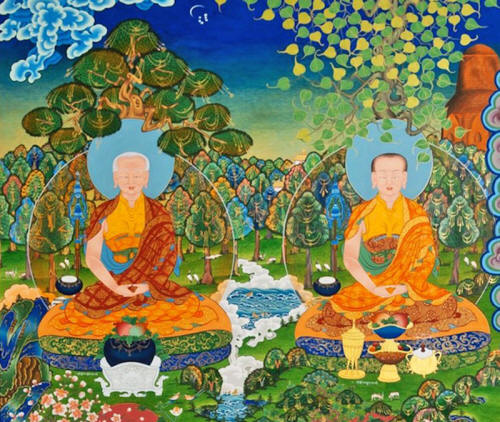|

November 08, 2016
from
MessageToEagle Website
Spanish version

We continue to explore our brain's incredible capabilities and this
time we take a closer look at ancient Tibetan secrets that reveal
how it's possible to create
a tulpa - a living
thought-form.
In your thoughts you can do almost anything.
You can travel to
distant places, meet remarkable people and do everything you always
dreamt of.
Pleasant thoughts can help and accompany you through hard times. In
Tibet, people are familiar with a certain ancient technique that
teaches a person
how to create a thought-form that can assume
human-form.
It is
known as a tulpa...

Tulpa is a
term term that comes from Tibetian
"to build" or "to
construct"
A tulpa is basically an entity created in the mind. It possesses the ability to act
independently of and parallel to your own consciousness. It is able
to think, and has its own free will, emotions, and memories.
In
short, a tulpa is like a sentient person living in your head,
separate from you.
In order to understand the nature of a tulpa, one has to accept that
a thought can have different purposes. It is also essential to
recognize the basic concept of a
thought-form.
Students of occultism learn that a thought can create a non-physical
entity that exists in either the mental or astral plane.
Every thought generates vibrations in the aura's mental body. It
assumes a floating form and its colors differ depending on the
nature and intensity of the thought.
These entities are called
thought-forms and they can be perceived visually by clairvoyants -
people who can predict future events.
According to mystics, thought-forms can be divided into three
categories.
-
In the first category we find thought-forms which represent the
image of a thinker.
-
In the second category, a thought-form represents an image of a
material object associated with the thought.
-
The third thought-form
is described as an independent image expressing the inherent
qualities of a thought.
Of course, we all know that thoughts are not always good...
Depending
on the situation and mood our thoughts can reflect many negative
feelings like hate, anger, greed and so on. These types of thoughts
are considered to be low in nature.
According to
occult teachings, thought-forms can be directed at
individuals. The duration, strength of a thought-form and how far it
can travel depends on the strength and clarity of the original
thought.
Sometimes people try to direct an evil thought at another person.
This can end in a disaster. If the thought-form cannot latch on to
similar vibrations in the aura of the recipient, it bounce back to
the sender.
Occasionally, a very powerful thought-form can go out of control and
when it happens it can turn against its creator.
People who have researched this subject believe that thought-forms
have the capability to assume their own energy and they appear to be
independent and intelligent.
There are also certain kinds of thought-forms that are very unusual
because they are created spontaneously.
These thought-forms are
produced by group minds, when several people concentrate on the same
thoughts or ideas.

Tibetan Buddhists have experimented with various thought-forms'
techniques and are able to create a temporary phantom form called a
tulpa.
According to Tibetan teachings, a tulpa is created with help of
mental and parapsychological exercises. A tulpa is a phantom form
and results of a person's imagination. If ones imagination is strong
enough, a tulpa can be visualized by its creator and perceived by
others.
Furthermore, tulpas can assume human-form and can be sent out on a
mission.
During one of her many journeys,
Alexandra David-Néel (1868 - 1969),
French explorer, author and scholar of Tibet successfully created a
tulpa. Unfortunately, the result was not was what she had hoped for.
Mrs. David-Néel spent months studying ancient Tibetan techniques and
finally she managed to produce her won tulpa!
Instead of attempting
to create a tulpa of a god or goddess, Mrs. David-Néel focused her
mind and tried to produce a monk.
She wished her monk to be,
"short
and fat, of an innocent and jolly type."
After a couple of weeks, she saw short glimpses of the monk. In
time, he became more and more real.
After several months of
performing the prescribed Tibetan ritual a life-like phantom monk
appeared.
At the beginning, Mrs. David-Néel did not notice any problems with
her tulpa. The lama often accompanied her when she went out. Once
she could even feel his hand touching her on the shoulder.
Then
something happened...
Her tulpa began to change from a fat, benevolent monk to a lean and
malevolent person. The lama did unexpected and unwished things. The
expression on his face became more threatening every day and his
behavior was troublesome.
Other people could actually see the monk, but he never bothered to
respond to anyone except to his creator.
Mrs. David-Néel understood that she had lost control of her tulpa
and decided to destroy him.
Her creation had turned into what she called,
"a living nightmare."
When she tried to dissolve the tulpa, according to specific Tibetan
rituals, the phantom monk managed somehow to resist her efforts.
It
took her six months, but at the end she prevailed and eliminated the
lama.
Her experience was unsettling and she termed it "very bad
luck."
We cannot tell you whether this story is entirely true. There are
several similar stories in Tibet.
Nevertheless, although the entire
concept sounds bizarre, one should not dismiss ancient Tibetan tulpa
techniques. It is a fascinating example of how the human mind can
create its own realities.
We should keep in mind that despite extensive research we still know
very little about our
brain's capabilities...
|




